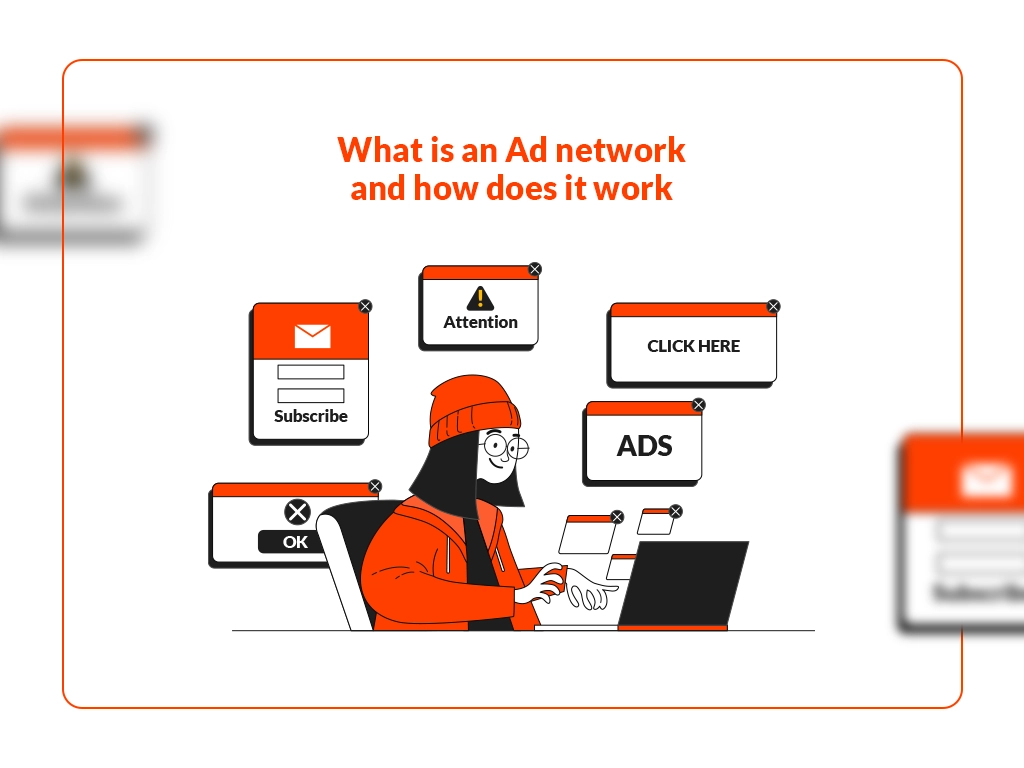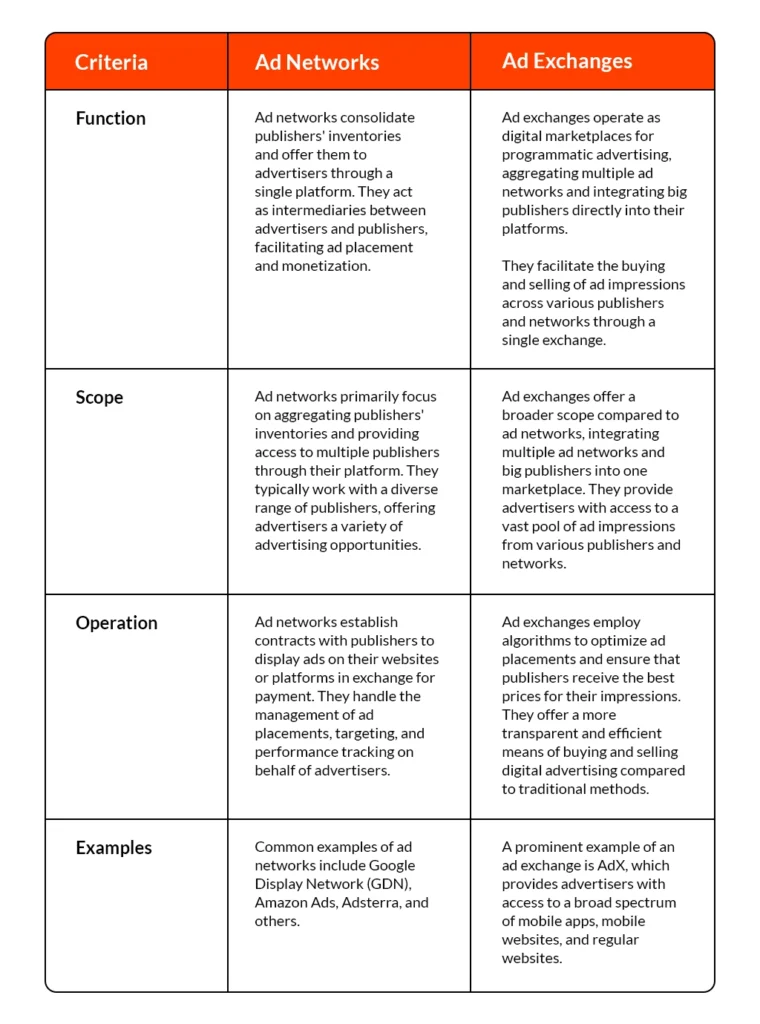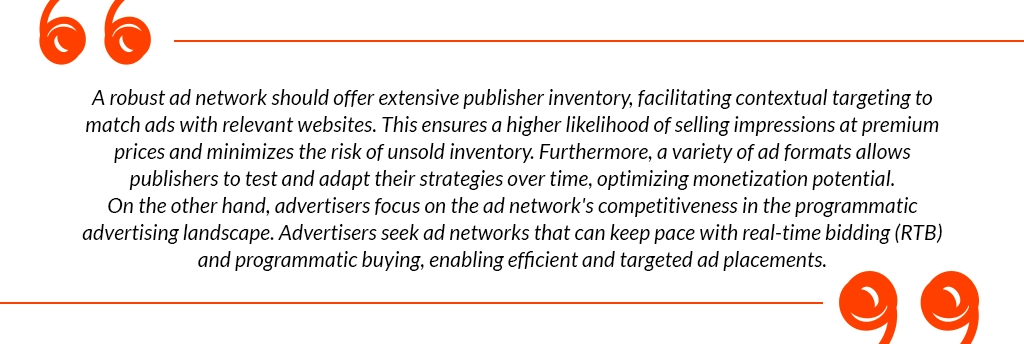What is an Ad network and how does it work?

What is an Ad Network?
An ad network serves as a vital intermediary between publishers and advertisers. In the realm of programmatic ads, these networks assume a pivotal role in facilitating the buying and selling of ad inventories. They are digital online advertising platforms that streamline the sale of ad inventories, bringing advertisers and publishers together in a seamless manner.
Before the advent of ad networks, advertisers were faced with the daunting task of individually contacting publishers. This process necessitated extensive one-on-one human interaction, which was not only time-consuming but also prone to inefficiencies. The introduction of ad networks in programmatic advertising has revolutionized this process, offering a more efficient and effective solution.
But how did ad networks come about?
When an advertiser shows interest in placing an ad on a website, the publisher negotiates a price based on where the ad will appear and what type it will be. For instance, a banner ad at the top of a page costs more because it’s more visible. Once they agree on a price, the publisher starts an insertion order, and both parties sign a contract. This process used to be manual and involved a lot of back-and-forth communication.
As the number of websites proliferated, advertisers needed help to keep track of where they wanted to advertise. With millions of web pages being created daily, finding the right publishers became challenging. Managing contracts and communication with each publisher became even more complicated.
To solve this problem, ad networks were introduced. Ad networks work as databases of publishers for advertisers, which means that advertisers can now reach out to multiple publishers simultaneously through these hubs.
Earlier, ad networks were merely a provision for publishers to sell unused ad spaces in their properties. But today, with the rampant growth of online platforms, ad networks have become an integral part of the larger programmatic advertising ecosystem.
Some of the common examples of ad networks are Google Display Network (GDN), Amazon ads, Adsterra, Epom, Adcash, Mediavine among others.
What does an Ad Network do?
Now that we know a bit about ad networks, let’s understand what it does!
Ad networks have multifarious utility both on the publisher’s and advertiser’s sides.
Let’s start with the supply side.
Picture this: a bustling marketplace where digital ad inventory is the currency. Ad networks act as the gatekeepers of this inventory, acquiring it through two primary methods.
First, they collect inventory directly from publisher sites, forming partnerships that allow them access to a wide array of digital platforms. Alternatively, they can purchase bulk impressions in one fell swoop, like buying in bulk at a warehouse store.
Once the inventory is secured, sorting through the heap is time. Ad networks employ sophisticated algorithms to match available impressions with advertiser demands. They consider price, target audience, and ad format to ensure the perfect match.
Now, on the demand side, advertisers enter the stage. Ad networks offer them a streamlined platform to manage their advertising campaigns efficiently. Think of it as a control center where advertisers can easily fine-tune their strategies.
Some ad networks even provide a hands-on approach, with dedicated account managers guiding advertisers every step of the way. Their expertise ensures that campaigns run smoothly and achieve optimal results.
These digital powerhouses include household names like Google AdSense, AppLovin, and media.net. Each offers unique features and specialties tailored to the diverse needs of advertisers and publishers alike.
What are the different types of Ad Networks?
Several types of ad networks exist in a programmatic advertising ecosystem:
1. Vertical: These ad networks are characterized by specific topics and are super niche, such as sports ad networks.
2. Horizontal: These ad networks cover multiple topics, offering a better reach and resulting in more impressions per day.
3. Premium: As the name suggests, these are a bundle of premium publishers with a steep attached cost. However, this investment is well worth it as these networks fetch high-quality impressions, better engagement, and more conversions. You can be reassured that your ads will be seen by a highly engaged audience.
4. Inventory-Specific: Some ad networks, such as display ad networks, native ad networks, or video ad networks, are inventory-specific.
5. Targeted ad networks: These are designed to deliver impressions specific to a particular audience behavior, leveraging data management platforms. They’re perfect for contextual targeting, especially if you have a target account list and insight into their behavior. In other words, they’re tailored to your needs.
Why do we need Ad Networks?
But what makes ad networks in the programmatic advertising ecosystem so crucial?
In the fast-paced world of digital advertising, ad networks serve as indispensable intermediaries, facilitating connections between advertisers and publishers.
These networks are pivotal in:
- Monetizing mobile advertising
- Providing technical integration
- Commercial mediation services
From a publisher’s perspective, ad networks offer a streamlined process to showcase their ad inventory and manage campaigns. This efficient integration simplifies transactions and payment processes, relieving publishers from the hassle of negotiating individual deals with each advertiser.
The emergence of ad networks directly responded to the challenges advertisers faced in effectively reaching their target audiences. These networks took the initiative to engage with publishers, regardless of their size, and built comprehensive databases of available inventory.
By establishing contracts with numerous publishers, ad networks became centralized hubs for advertisers to access various advertising opportunities.
Over time, ad networks like Google Display Network (GDN) have transformed into expansive platforms connecting advertisers with many publishers. They enable advertisers to reach diverse audiences across various websites efficiently. Furthermore, ad networks have democratized digital advertising, allowing smaller publishers to monetize their content and engage with advertisers on a larger scale than ever before.
In essence, ad networks are not just intermediaries but the linchpin of the digital advertising ecosystem. They play a crucial role, underscoring their significance, in facilitating the exchange of ad supplies from publishers to seamlessly meet advertisers’ demands. They empower advertisers to connect with valuable impressions across a spectrum of publishers, ensuring efficient and targeted advertising campaigns in today’s digital landscape.
How does an Ad Network work?
On SSP side, ad networks help publishers to secure buyers for unused & unsold ad spaces. Whereas, on the DSP side, ad networks help advertisers find inventory that fits their budget and audience profile.
Step 1: Installation on the SSP side
The process begins when a publisher installs an ad network of their choice on their platform. This involves integrating the necessary code or software provided by the ad network into their website or app.
Step 2: Campaign setup on the DSP side
Simultaneously, advertisers set up their ad campaigns through the ad network of their choice. They access the ad network’s platform or dashboard and create campaigns tailored to their specific goals and target audience.
Step 3: Campaign Configuration
Advertisers define the parameters for each campaign, including crucial details such as budget, targeting criteria (demographics, interests, geography), and frequency caps (how often the ad should be shown to the same user).
Step 4: Matching Advertiser Requirements
Based on the criteria set by the advertiser, the ad network’s algorithms swing into action. They analyze available ad inventory across the network of publishers to identify the best match for each campaign.
Step 5: Connecting Publisher and Advertiser
Once the ad network identifies suitable ad placements, it facilitates the connection between the advertiser and the selected publisher. This involves serving the advertiser’s ad content on the publisher’s platform, ensuring seamless integration and delivery to the target audience.
Step 6: Campaign Monitoring and Optimization
Throughout the campaign duration, both advertisers and publishers monitor performance metrics provided by the ad network. This data allows them to assess the effectiveness of the campaign and make adjustments as needed to optimize results.
Step 7: Reporting and Analysis
At the conclusion of the campaign, the ad network provides comprehensive reports detailing key performance indicators (KPIs) such as impressions, clicks, conversions, and return on investment (ROI). Advertisers and publishers use this data to evaluate campaign success and inform future strategies.
Through seamless integration and optimization, ad networks ensure effective advertising campaigns that reach the right audience at the right time. Understanding how ad networks work means understanding how programmatic advertising ecosystem functions.
Ad Network vs Ad Exchange
Ad networks are a collection of publishers any advertiser can choose from. Ad networks also buy impressions in bulk which they sell to advertisers. Whereas ad exchange is the central unit of the programmatic advertising ecosystem through which the buying and the selling finally take place between the parties. Below is a tabulated differences between Ad Network & Ad Exchange.
Benefits for Publishers and Advertisers
Integrating ad networks into your digital marketing strategy offers a number of benefits. The benefits for publishers and advertisers vary depending on their role, objectives, and usage. Say, if you are a publisher, it will help you in monetizing your platform and a taste of a big slice of the global marketing pie.
Benefits for Publishers:
i. Quick Monetization Opportunity:
Ad networks provide publishers with a golden opportunity to monetize their digital properties effectively. For example, a lifestyle blog can partner with Google AdSense to display relevant ads and earn revenue based on user interactions.
ii. Streamlined Revenue Generation:
Partnering with ad networks streamlines revenue generation for publishers. A niche gaming website, for instance, can effortlessly display targeted ads to its audience through platforms like Adsterra, maximizing earnings with minimal effort.
iii. Increased Exposure:
Ad networks broaden publishers’ exposure by connecting them with a diverse range of advertisers. A popular cooking app, for instance, can leverage AdMob to showcase its ad inventory to a global audience, unlocking new revenue streams.
iv. Efficient Management:
Ad networks handle the intricacies of ad placements and payment processing, freeing publishers to focus on content creation. Platforms like Media.net provide publishers with seamless management tools, simplifying the monetization process.
v. Access to Quality Ads:
Ad networks ensure publishers have access to high-quality ads that enhance user experience. A travel website partnering with Taboola, for instance, can showcase engaging sponsored content that resonates with its audience, fostering trust and engagement.
Benefits for Advertisers:
i. Hyper Personalized Targeted Advertising:
Ad networks empower advertisers with advanced targeting options to reach their desired audience. A fitness apparel brand, for instance, can leverage Facebook Audience Network to target fitness enthusiasts with tailored ads, driving conversions.
ii. Expanded Reach:
By partnering with ad networks, advertisers can expand their reach across diverse platforms and channels. A mobile gaming company, for example, can utilize Unity Ads to reach gamers across a wide range of mobile apps, maximizing exposure and user acquisition.
iii. Cost-Effectiveness:
Ad networks offer cost-effective pricing models that optimize ad spending and ROI. A startup business, for instance, can utilize LinkedIn Ads to target professionals in their industry with precision, achieving maximum impact within a limited budget.
iv. Flexibility and Control:
Ad networks provide advertisers with flexibility and control over their ad campaigns. A fashion retailer partnering with Outbrain, for example, can easily customize ad creatives and adjust targeting parameters in real-time, ensuring campaigns are tailored to specific objectives and audience segments.
v. Performance Tracking:
Ad networks offer robust analytics and reporting tools that enable advertisers to track campaign performance and make data-driven decisions.
How to choose the right Ad Network?
As of today, there are a lot of ad networks out there. The market is swarming with these ad networks. Therefore, it becomes imperative that we know which ad network to opt for. Again, as a publisher you will have different goals and objectives. You might want to be in an ad network that bundles you with the heavy weights. Or you might want to bundle your platform with only those showing video ads.
Whereas, if you are an advertiser, you might want to opt for an ad network that has smaller publishers given your budget constraints. So, a lot of it depends which component you are in the advertising ecosystem and what are your basic goals and the challenges you want to address.
When it comes to choosing the right ad network, both publishers and advertisers have distinct priorities. For publishers, the emphasis lies on maximizing revenue potential through broad network reach and diverse ad formats.
Integration with modern programmatic technologies is crucial for advertisers to reach their desired audience effectively and maximize campaign performance. By considering these factors, both publishers and advertisers can select ad networks that align with their goals and drive success in the digital advertising realm.
For Publishers:
i. Extensive Publisher Inventory:
Look for ad networks with a broad reach, encompassing a wide range of publishers and websites. A larger network increases the potential to sell impressions at higher prices and reduces the risk of unsold inventory.
ii. Variety of Ad Formats:
Choose ad networks offering multiple ad formats, such as rich media, video rolls, and interstitials. Diverse ad formats optimize monetization potential and allow for testing and adaptation over time.
For Advertisers:
i. Competitiveness in Programmatic Landscape:
Assess whether the ad network can compete with real-time bidding (RTB) and programmatic advertising. Integration with modern programmatic technologies ensures efficient and targeted ad placements, maximizing campaign performance.
Conclusion
In conclusion, ad networks play a crucial role in the digital advertising ecosystem, serving as vital intermediaries between publishers and advertisers. They streamline the buying and selling of ad inventories, offering benefits such as efficient monetization, expanded reach, and targeted advertising. Whether you’re a publisher looking to maximize revenue potential or an advertiser aiming to reach your target audience effectively, choosing the right ad network is paramount.
Consider factors like network reach, ad formats, and competitiveness in the programmatic landscape to make an informed decision. As the advertising landscape continues to evolve, staying updated on emerging technologies and trends will be key to unlocking new opportunities and driving success in the digital realm.
Robery Kiyosaki once said that the richest people in the world look for and build networks. And I say, the biggest businesses in the world look for programmatic ads and utilize the best ad networks.



